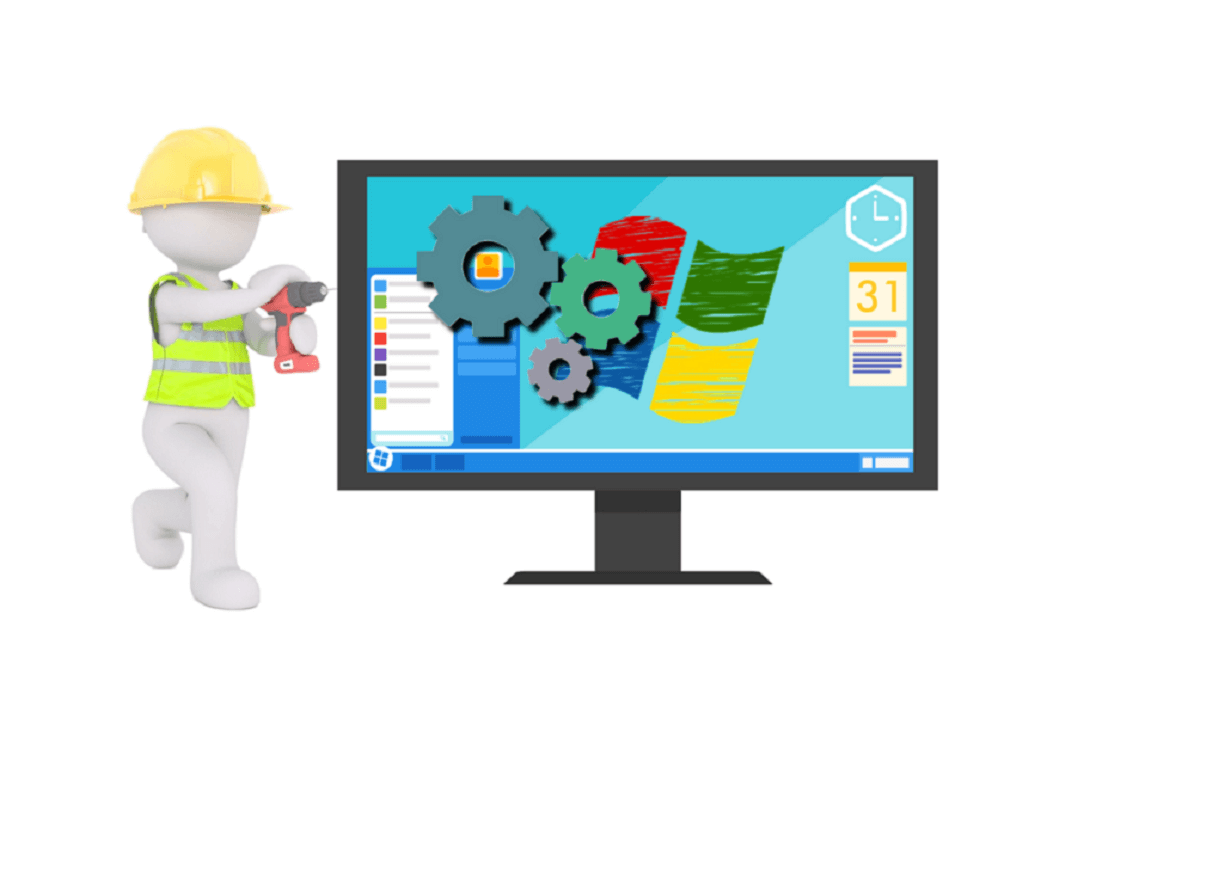- Restart The Computer System The Ram is volatile memory, you’ll lose its contents when your computer turned off. Restarting your computer system will clear memory saved on RAM and reset all the running programs and applications. However, this method won’t clear the complete memory but it will boost up the processing speed of the system.
- Cleaning up the Disk on Windows: Open Start ('Start' icon). Click the Windows logo in the bottom-left.
Click the Disk Cleanup and click OK This will delete all the unnecessary files on your Windows system and free up your RAM. Now your PC is free from unwanted programs and files, thus increases PC performance. Didn't you feel this as a lengthy procedure and requires extra care and time.
Windows PC Clean Tips
Fix Computer is Slow
Windows Cleanup Tips
Speed Up Windows PC
No matter how hard you try to keep your Windows 10 machine clean, eventually it will collect many types of junk files and other unwanted stuff. It then becomes a real headache to get rid of all of these unwanted files from your machine. Fortunately, though, there are some ways you can use to remove these unwanted files and data from your computer.
In the following guide, you are going to learn what are the items taking up your memory space and how you can clean up your Windows 10 PC. It shows multiple cleaning methods so you can be sure there is no junk left on your computer.
Items Occupying Memory in Windows 10
First of all, let’s check out what are the items taking up the memory space on your computer. Once you have found these items, you can then learn how you can get rid of them from your PC.
Item 1. Files Downloaded from Internet
Internet is where everyone downloads their files from and you have likely downloaded a lot of files from there on your computer. If you have done so, it is likely there are a lot of single usage files residing in the downloads folder on your computer. These files may be occupying a large amount of your memory space.
Item 2. Full Recycle Bin

When a file is deleted from your computer, it goes straight to the Recycle Bin. Over the time, the Recycle Bin gets full and all of your deleted files continue to exist. These files do use some of the memory space on your computer.
Item 3. Temporary Files
Temporary files provide quick data to the applications installed on your computer. If the apps do not delete these files after their usage, you will have a number of these useless files sitting on your computer and utilizing your precious memory space.
Item 4. Unwanted Applications
It happens to many of you that you install an application, use it once, and then forget it forever. The app continues to exist on your machine and constantly uses your memory space. This adds to the clutter of your machine.
Item 5. Log Files
Many of the apps on your computer use log files to keep track of their activities. For most of the users out there, these log files are of no use but they do take up a good amount of your memory space.
How to Clean up Window 10

Now that you have learned what items are occupying your memory space and cluttering your PC, this section will tell you how you can clean up your computer running Windows 10.
There are a number of methods you can use to clean up your machine and the following are eight of those methods for you.
Method 1. Clean up Windows 10 – Delete Internet Files
In this method, what you need to do is open the folder where your Internet files are saved in, find the files you no longer need, and delete them from your computer. It sounds easy to do and it is and it does wonders for you.
Once you have removed the useless Internet files from your computer, have a look at the available memory space and you will be surprised.
Method 2. Clean up Windows 10 – Clean Up Recycle Bin
If you have been adding files to Recycle Bin but never fully cleaned it up, you may want to do it now. Cleaning up the Recycle Bin will remove all the files sitting in it permanently from your computer.
You can do it by right-clicking on the Recycle Bin icon on your desktop and choosing the Empty Recycle Bin option.
Method 3. Clean up Windows 10 – Remove Temporary Files

Disk Cleanup is one of the cleaning tools that comes preloaded on your PC and lets you remove unwanted files with a few clicks. It is extremely easy to use the tool as all you need to do is select what items to be removed from your system and hit submit.
You can search for Disk Cleanup from your search function to find and launch the utility on your PC.
Method 4. Clean up Windows 10 – Enable Storage Sense on Your PC
Storage sense is a built-in feature on your Windows 10 computer that allows you to automatically free-up memory space when you are running low on memory. Your computer does the cleaning task for you but first you need to enable the feature as shown below.
Clean up Windows 10 – Enable Storage Sense on Your PC
Open the Settings app on your PC and click on System followed by Storage. You will find a toggle under the Storage sense section. Simply turn the toggle to the ON position and the feature will be enabled on your PC.
Method 5. Clean up Windows 10 – Turn Off Hibernate
Hibernate provides you with a quick way to get back to your computer after you have put it in sleep mode. In order to do that, the feature saves states of all the running apps on your computer. It adds to the clutter of your machine and therefore you should keep the feature turned off if you wish to unclutter your computer.
To disable hibernate on your PC, press the Windows + X key and select Command Prompt (Admin). Type in the powercfg.exe /h off command hit Enter. The feature will be disabled.
Method 6. Clean up Windows 10 – Upload Files to Cloud Storage
With the availability of a number of cloud storage providers, you should consider storing your files on the cloud rather than on your local storage. This will give you more space to play with on your Windows 10 computer and you can always fetch the files you want from your cloud provider.
Method 7. Clean up Windows 10 – Uninstall Apps You Don’t Use
Apps are big time memory sucker and if you have a lot of these installed on your computer, you may want to remove the ones you no longer use. It can be done from the Settings app or Control Panel.
Method 8. Clean up Windows 10 – Remove Junk Files
If you would not prefer performing a manual search for junk files on your computer, you can use a dedicated app to clean up your machine.
One of these apps is Ashampoo WinOptimizer that cleans up and optimizes your system for an improved performance. It is extremely easy to use the app and it has tons of features to help you thoroughly clean your computer.

- Some of the features worth mentioning here are:
- Simple and easy one-click optimization.
- Automatically find and remove junk files from the PC.
- Optimize the Windows Registry so it works faster.
- Defrag your drives with the built-in feature.
If you would like to give a try to the app, the following is how you obtain and use it on your Windows 10 computer.
Step 1 Download and install the Ashampoo WinOptimizer tool on your computer. When it launches, click on the option that says Maintain system in the left hand side and then choose Drive Cleaner from the right side.
How to Clean Up Windows 10 – Step 1
Step 2 The following screen will tell you what junk files it can remove from your machine. Review the list and then click on the Delete now button to start removing those files on your computer.
Step 3 Once all the junk files are removed, the following message will be shown on your screen.That is how you clean up your Windows 10 PC using a nice little application.
How to Clean Up Windows 10 – Step 3
The Bottom Line
If your Windows 10 has become all cluttered and you can’t find a way to remove the clutter, the above guide will give you some ideas on how you can get rid of junk stuff and improve the overall performance of your computer.
Product-related questions? Contact Our Support Team to Get Quick Solution >
Anyone who regularly works with a computer and has to deal with software which requires a lot of processing power knows how important powerful hardware is. Most people immediately think of the processor or graphics card (especially when the focus is on image and video editing). However, the main memory is also of fundamental importance for the smooth operation of the system and other software. This memory is required by the processor to manage the data of running programs and services or processes. The capacity of the main memory has a decisive influence on how many applications can be loaded simultaneously and how quickly data can be processed.
In principle, the more memory, the better. However, since the costs also play a role and the RAM memory cannot be expanded, many people use a fairly simple trick when the memory reaches its limits - deleting processes that are no longer required from the cache, and creating space for the data that is relevant for your current activities. This increasing your RAM. So all you do is clear the RAM or free it up.
- Free up your RAM – here’s how
What is the function of the main memory?
The main memory, also called RAM memory, is the central storage unit for all data that is required for programs or program parts that are currently running and for all active system processes. This memory, whose data is automatically lost when the computer is switched off, is accessed directly by the processor. If there is not enough memory available to process the relevant data during such an access attempt, the execution of the respective application will not work. The more processes take place simultaneously and the higher the system requirements of the executed programs, the more important a high capacity RAM becomes.
Which factors are vital for an efficient RAM?

The performance of the main memory is affected by the following three factors:
- Access speed: time required for successful access (write or read operation)
- Data transfer rate: a value that indicates the amount of data that can be transferred in a given time
- Memory capacity: available RAM
These three things are essential for the efficiency of the main memory in managing processes to be executed. Capacity is of particular importance, as it sets a strict limit to the storage capacity. For example, if an application requires 2 gigabytes and another 3 gigabytes of memory over a longer time, both cannot run simultaneously if only 4 gigabytes of memory are available. However, when it comes to processing a large number of temporary processes, access speed and data transfer rate come into play. The faster the individual data is processed and then disappears from the main memory, the faster space is freed up from the RAM for new processes.
Why is it a good idea to clear your RAM? And when should you do this?
A slow PC can be frustrating, especially when you need to problem solve and use your computer quickly. An ever decreasing performance of the computer is often connected with straining the RAM. On the one hand, it is already automatically occupied by the operating system and system processes, on the other hand, it gets a bit fuller with every open program. Often it is of little use to close programs again. The latter is due to the fact that all files are rarely deleted from memory when you close an application. In addition, there are programs and processes that are active but not actually needed. For the above reasons, it may be advisable to clear the RAM if your computer shows signs of a significant decrease in performance
Free up your RAM – here’s how
Even if you are unsure whether your computer's memory is actually too full, you can try and free it up anyway. This way you’re only pre-empting an operation that would be performed automatically when you turn off your computer (but save the files you are working on so that your work results are not lost). In general, you have three different options for clearing your RAM manually:
- Empty the working memory via the task manager of your system
- Write a script that releases used memory
- Use an external tool that has a function for emptying RAM memory
The following sections explain what you need to do in detail.
To clear the RAM in Windows 7, 8, and 10 via the task manager
The task manager has long been an established feature in Windows systems. The background service lists running applications, services, and processes and also provides an overview of CPU and memory usage. Opening the Windows service works across all Windows versions by pressing the key combination[Ctrl] +[Shift] +[Esc]. Press these three buttons simultaneously to open the interface. Alternatively, you can also use the Windows search: Simply enter the term “Task Manager” and then click on “View running processes with Task Manager.”
To use the task manager to empty the working memory under Windows 7 and other versions select the “processes” tab:
Now go through the list of active processes and search for those that you do not need – for example, because you have already closed the program. Select the corresponding processes with a left or right click and press “end task” to close them permanently and clean up the working memory piece by piece.
Empty memory via script: the necessary steps
An interesting alternative to memory management via the task manager is to write a script that frees up a specified amount of RAM when it is executed. That sounds like a complex task at first glance – but you don't need any programming experience. A small entry in a simple text document created for this purpose is completely sufficient. To create a script to clear the RAM, proceed as follows:
Create a new text document by right-clicking on your desktop and selecting “new” and “text document” in the pop-up menu:
Open the created document and insert the following line of text:
Then save the file under the desired name. Make sure that ANSI is set as the encoding form if the editor offers an appropriate option. The last step is to replace the default extension .txt with the extension .vbs. Only in this way can Windows determine that the file is a script.
You can now execute the script simply by double-clicking it. The code proposed here automatically releases 32 megabytes of main memory, and this process can be repeated as often as required. Of course you can also adjust the amount and empty 128 megabytes (“Space(128000000)”). However, the value should never exceed half of the built-in memory size – otherwise there is a risk of program errors or even system crashes.
How to clear RAM with external tools
If you want to use an external solution instead of the system-internal possibilities for memory cleaning, this is also possible without problems: there are various programs that were developed especially for this purpose and are mostly freeware. One of the most popular tools of this kind is Wise Memory Optimiser. The program by the developer company WiseCleaner is completely free of charge and available for all current Windows systems. After you install and start Wise Memory Optimizer, you will be taken to the main screen of the application, which displays both the occupied and free memory. With a single click on “Optimize Now” you can use the tool to empty the memory under Windows XP up to 10.
Clean Memory Pc Windows 10
Under the tab “settings” (the gear symbol), you can activate auto-optimization. Use the slider to specify how much should be cleared from the RAM automatically (for example, if less than 1280 MB is free, then the RAM should be optimized).
How To Clean My Pc Memory Mac
As an alternative to Wise Memory Optimizer, you can also use the tools RAMRush or Mz RAM Booster to clear your RAM.
How To Clean My Pc Memory Cards
